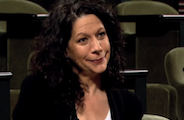Until recently, the ability of bacteria to communicate with each other was considered an anomaly limited to only a few marine species. Now, it’s clear that group talk is the norm in the bacterial world, and that understanding how bacteria communicate can provide us with clues for fighting deadly strains of bacteria.
Bonnie Bassler discovered that bacteria communicate with a chemical language. The process – called quorum sensing – allows bacteria to count their numbers, determine when they have reached a critical mass, and change their behavior in unison to carry out processes that are effective only when cells work together.
One process commonly controlled by quorum sensing is virulence. If virulent bacteria secrete their toxins too soon, a host’s immune system will quickly eliminate the nascent infection. So bacteria make sure their numbers are high enough to launch a simultaneous attack, to increase the chance of overpowering the immune system. Quorum sensing, Bassler says, allows bacteria to act like enormous multicellular organisms. She has shown that the same basic mechanism of communication exists in some of the world’s most virulent microbes, including those responsible for cholera and plague.
Working with Vibrio harveyi, a harmless marine bacterium that glows in the dark, Bassler and her colleagues discovered that this bacterium communicates with chemical signaling molecules called autoinducers. Many of these molecules allow V. harveyi bacteria to chat among their close relatives, but one molecule – that Bassler named AI-2 – allows them to talk to other bacterial species in the vicinity. Bassler showed that a gene called luxS is required for production of AI-2, and that hundreds of bacterial species have this gene and use AI-2 to communicate. This work suggests that bacteria use a universal chemical language to talk between species.
Now, Bassler’s team is trying to figure out how to disrupt quorum-sensing discourses so that bacteria can no longer communicate. A successful strategy could potentially be used for antimicrobial therapy. Recently, her team began working on understanding and disrupting quorum sensing in bacterial biofilms. These surface-attached communities of bacteria are the predominant form of bacterial life on Earth. They are also notorious for causing complications in infections because the bacteria that reside inside of the films are highly antibiotic resistant and difficult to eradicate. Quorum sensing controls biofilm development, and Bassler believes that if an anti-quorum-sensing strategy is to be successful as a therapeutic, it must work in the context of bacterial biofilms. Her lab is developing new imaging, microfluidic, and genetic technologies to study quorum-sensing control of biofilm development from the single cell to the community.
Bassler’s interest in bacterial communication grew from her curiosity about how information flows among cells in the human body, and she is convinced she will find parallels between bacterial systems and those in higher organisms. “If we can understand the principles governing the process in bacteria,” she explains, “what we learn could hold true in higher organisms.”
In 2002, Bassler won a MacArthur Fellowship, which she says provided tremendous validation for her group’s research, recognizing that they are working on a problem that is much larger than a glow-in-the-dark bacterium. Since then, she has received a number of honors, including the Wiley Prize, the Lounsbery Award, and the Shaw Prize in Life Science and Medicine.












